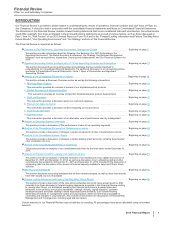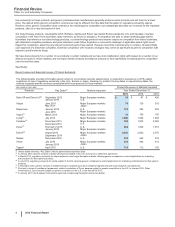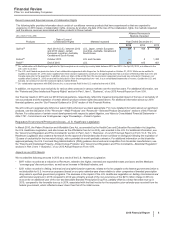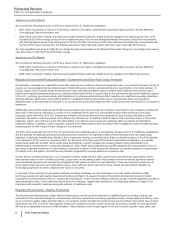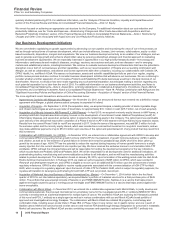Pfizer 2015 Annual Report Download - page 8
Download and view the complete annual report
Please find page 8 of the 2015 Pfizer annual report below. You can navigate through the pages in the report by either clicking on the pages listed below, or by using the keyword search tool below to find specific information within the annual report.
Financial Review
Pfizer Inc. and Subsidiary Companies
2015 Financial Report
7
with respect to any specific R&D project, there can be no assurance that the development of any particular product candidate or new
indication for an in-line product will achieve desired clinical endpoints and safety profile, will be approved by regulators or will be successful
commercially. We continue to strengthen our global R&D organization and pursue strategies intended to improve innovation and overall
productivity in R&D to achieve a sustainable pipeline that will deliver value in the near term and over time.
During the development of a product, we conduct clinical trials to provide data on the drug’s safety and efficacy to support the evaluation of its
overall benefit-risk profile for a particular patient population. In addition, after a product has been approved and launched, we continue to
monitor its safety as long as it is available to patients, and post-marketing trials may be conducted, including trials requested by regulators and
trials that we do voluntarily to gain additional medical knowledge. For the entire life of the product, we collect safety data and report potential
problems to the FDA and other regulatory authorities. The FDA and regulatory authorities in other jurisdictions may evaluate potential safety
concerns related to a product or a class of products and take regulatory actions in response, such as updating a product’s labeling, restricting
the use of a product, communicating new safety information to the public, or, in rare cases, removing a product from the market.
Competition
Many of our prescription pharmaceutical products face competition in the form of branded or generic drugs that treat similar diseases or
indications. For additional information, see the “Competition” section in Part I, Item 1, “Business”, of our 2015 Annual Report on Form 10-K.
The Global Economic Environment
In addition to industry-specific factors discussed above, we, like other businesses, are exposed to the economic cycle, which impacts our
biopharmaceutical operations globally.
• We believe that patients, who are experiencing increases in co-pays and restrictions on access to medicines as payers seek to control
costs, sometimes switch to generic products, delay treatments, skip doses or use less effective treatments. We are exposed to negative
pricing pressure in various markets around the world. The U.S. has highly competitive insurance markets, and Europe, Japan, China,
Canada, South Korea and a number of other international markets have government-mandated reductions in prices and access
restrictions for certain biopharmaceutical products to control costs for the government-sponsored healthcare system, particularly under
recent global economic pressures. Furthermore, some government agencies and third-party payers use health technology assessments in
ways that, at times, lead to restricted access to and lower prices for new medicines.
• We continue to monitor developments regarding government and government agency receivables in several European markets, including
Greece, where economic conditions remain challenging and uncertain. For further information about our Accounts Receivable, see the
“Analysis of Financial Condition, Liquidity and Capital Resources” section of this Financial Review.
• Significant portions of our revenues and earnings, as well as our substantial international net assets, are exposed to changes in foreign
exchange rates. We seek to manage our foreign exchange risk in part through operational means, including managing same-currency
revenues in relation to same-currency costs and same-currency assets in relation to same-currency liabilities. Depending on market
conditions, foreign exchange risk also is managed through the use of derivative financial instruments and foreign currency debt. As we
operate in multiple foreign currencies, including the euro, the Japanese yen, the Chinese renminbi, the U.K. pound, the Canadian dollar
and approximately 100 other currencies, changes in those currencies relative to the U.S. dollar will impact our revenues and expenses. If
the U.S. dollar were to weaken against another currency, assuming all other variables remained constant, our revenues would increase,
having a positive impact on earnings, and our overall expenses would increase, having a negative impact on earnings. Conversely, if the
U.S. dollar were to strengthen against another currency, assuming all other variables remained constant, our revenues would decrease,
having a negative impact on earnings, and our overall expenses would decrease, having a positive impact on earnings. Therefore,
significant changes in foreign exchange rates can impact our results and our financial guidance.
The impact of possible currency devaluations in countries experiencing high inflation rates or significant exchange fluctuations, including
Venezuela, can impact our results and financial guidance. In 2015, we recorded a foreign currency loss of $806 million and an inventory
impairment charge of $72 million related to recent conditions in Venezuela. For further information about our exposure to foreign currency
risk, see the “Analysis of Financial Condition, Liquidity and Capital Resources” and the “Our Financial Guidance for 2016” sections of this
Financial Review. For further information about our foreign currency losses related to Venezuela, see Notes to Consolidated Financial
Statements––Note 4. Other (Income)/Deductions––Net.
Despite the challenging financial markets, Pfizer maintains a strong financial position. Due to our significant operating cash flows, financial
assets, access to capital markets and available lines of credit and revolving credit agreements, we continue to believe that we have, and will
maintain, the ability to meet our liquidity needs for the foreseeable future. Our long-term debt is rated high quality by both Standard & Poor’s
(S&P) and Moody’s Investors Service (Moody’s). As market conditions change, we continue to monitor our liquidity position. We have taken
and will continue to take a conservative approach to our financial investments. Both short-term and long-term investments consist primarily of
high-quality, highly liquid, well-diversified, available-for-sale debt securities. For further discussion about our financial condition, see the
“Analysis of Financial Condition, Liquidity and Capital Resources” section of this Financial Review.
These and other industry-wide factors that may affect our businesses should be considered along with information presented in the “Forward-
Looking Information and Factors That May Affect Future Results” section of this Financial Review and in Part I, Item 1A, “Risk Factors,” of our
2015 Annual Report on Form 10-K.


